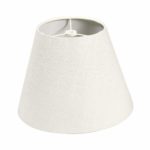How to Choose the Right Lampshade

One out of all the best ways to change the appearance of a room is to buy a new lampshade. A new lamp shade will not only offer a better look for the specific lamp it is placed on but will also improve the room’s lighting by increasing or decreasing the amount of light the lamp emits.
Mostly the emphasis on lampshade decisions is based on decorative and aesthetic characteristics they offer. Concentrating on only the appearance of the lampshade, though, can lead the issue down the road.
Let’s get to some details to ensure you are not wasting your valuable time when making your decision.
Lamp shade Measurement
what often becomes the more natural step in the process is the one that gets skipped. It is essential to measure lampshades to make sure they will fit onto your fixture. They have three distinct measurements which you will need to consider when purchasing:
- The top diameter.
- The bottom diameter.
- The side length.
You can order a customized shade but may be able to find a common shade size in stock that will work. You can always discuss with lampshade sources such as All-Lite for the measurements of shade you are thinking of purchasing.
Lampshade Materials
Another important thing you will also want to consider is what material your lampshade is made of when dealing with the quantity of light you would like the lamp to produce. They often come in a variety of materials such as glass, linen, burlap, porcelain, shantung, crystal, rustic weaves, translucent, metal, oiled parchments, leather, exotic and plain papers, and many other types of fabric.
Immediately, you have the measurements and the type of materials you’d like your lampshade to be made of; then it is time to select the correct fitting.
Types of fittings for lampshades
The fitting is merely the way your lampshade will be connected to your lamp. There are three ways in which this can be accomplished, and we will jump right into explaining g them now.
The most common lampshade fitting is called the spider. It has risers attached to the harp to resize the shade. This is a perfect fitting if you are planning on using different lampshades at different times of the year.
An Uno lamp shade does not use the harp and cannot be resized, as it connects directly to the lamp socket. This type of shade is commonly found in smaller lamps. A Clip-on fitting can be found in both large and small lamps, including a chandelier — the fitting clips directly onto the light bulb.
Other tips to consider
The height of the lampshade should be about 3/4ths of the height of the base.
You should allow a space of at least three inches between the shade and the light bulb, so the lampshade does not become a fire hazard. That being said, also always remember that crystal and glass lampshades require smaller bulbs.
Lamp shades are universal. You can use them on fixtures which you may not have considered using them with like a chandelier, for example. The old western style chandelier commonly used lampshades.
Recent Posts
Best Smart Light Switch For Google Home
6th May 2023Best No Hub Smart Bulbs For Alexa And Google Home
6th May 2023How to connect smart light to google home
6th May 2023Best 2 burner induction cooktop built-in
29th April 2023Related Articles
Best Smart Light Switch For Google Home
Everything in our houses is becoming smarter as a result of technological...
ByOlaoluwa Johnson T.6th May 2023Best No Hub Smart Bulbs For Alexa And Google Home
No hub smart bulbs are a sign of how far smart home...
ByOlaoluwa Johnson T.6th May 2023How To Install Ceiling Light Without A Junction Box
If you are in search of finding out a way of installing...
ByOlaoluwa Johnson T.3rd December 2021How to install track lighting without an existing fixture?
Investing in a home is every individual’s dream. Once you purchase the...
ByOlaoluwa Johnson T.17th August 2020








